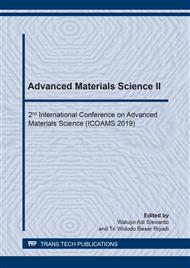p.94
p.101
p.111
p.117
p.123
p.129
p.135
p.144
p.150
Investigating the Potential Use of Cassava Leaf Extract as a Natural Coloring Substance for Fabrics
Abstract:
In this modern era, most of the textile industries used synthetic dyes for coloring their fabrics. The reason why most of textile companies use synthetic dyes is that synthetic dyes are easier to obtain, the availability of colors is guaranteed, vast variety of colors, good color fastness. Nevertheless, the use of synthetic dyes in the textile industries has caused environmental problems if the waste not treated properly. Additionally, synthetic dyes commonly contain chemicals which are not good for human health. They can cause cancer, attack the nerves of the brain, etc. Therefore, most of people now focus on using natural dyes as alternative to subtitute synthetic dyes. Nowdays, in Indonesia, naturally-dyed textile products, such as Batik tulis (using natural dyes) has a high market potential as a superior commodity of Indonesian products to enter the international market. Therefore, to develop the use of natural dyes in the textile industries, it is necessary to explore the sources of natural dyes from various potential natural resources in Indonesia. Most of these natural dyes are coming from the plants. Cassava leaf is widely known and used for cooking by the people of Indonesia. Based on the literature, cassava leaf contains natural pigments such as chlorophyll a, chlorophyll b, xanthophyll, carotene, and anthocyanin Based on this, we took the initiative to conduct research to investigate the potential use of cassava leaves extract as natural coloring substance for coloring fabrics. In this research, Cassava leaf extract has been obtained via solid-liquid extraction process using two different solvents, ethanol (96%) and n-hexane. From this study, it was found that the most optimum extract resulted from the extraction process was about 1.67% with ratio of cassava leaves and ethanol solvent of 1:10. This extract was then used for coloring the cotton cloth. After colored, the cloth was then tested for its color fastness by two methods, namely rub method and washing with soap. From the test results, it was found that the fabric dyed with cassava leaf extract was not much able to withstand against rubbing and washing with soap. Based on this result, further research is needed, such as using other agents during the mordanting and fixation processes
Info:
Periodical:
Pages:
123-128
Citation:
Online since:
May 2020
Authors:
Keywords:
Price:
Сopyright:
© 2020 Trans Tech Publications Ltd. All Rights Reserved
Share:
Citation:


